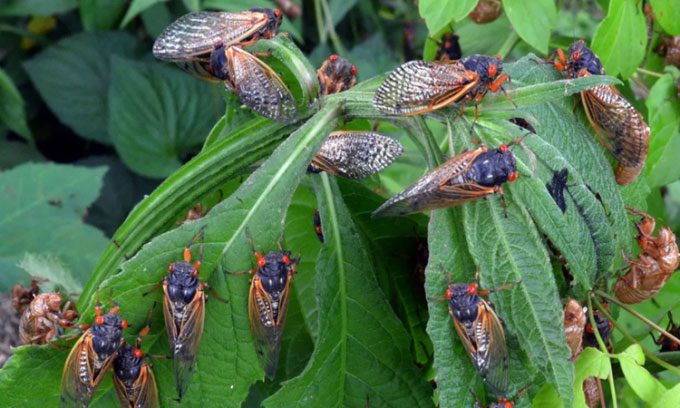Two groups of cicadas, Brood XIII and Brood XIX, are set to emerge simultaneously during a rare dual event, causing the cicada population across 16 states in the United States to reach trillions.
More than a trillion cicadas are expected to surface across the Midwest and Southeast regions of the United States this spring as two distinct groups emerge together for the first time since 1803. The Brood XIII group and the Brood XIX group represent two separate periodic cicada (Magicicada) groups that emerge on respective cycles of 17 years and 13 years. In a rare natural event that occurs every 221 years, these two groups will simultaneously burrow through the ground to the surface, starting in late April across 16 states. This dual emergence could lead to hybridization between the two groups, as reported by Live Science on February 6.

Cicadas emerge on a 13 or 17-year cycle in the U.S. (Photo: Gene Kritsky/Mount St. Joseph University)
“Under the right conditions and with an appropriate number of individuals for hybridization, it’s possible for a new group to start a new cycle”, said Floyd Shockley, an entomologist and collection manager at the Smithsonian National Museum of Natural History.
Periodic cicadas, which include seven species, spend most of their lives underground in a nymph stage, feeding on sap from tree roots. After 13 to 17 years of living without sunlight (depending on the species), these insects will dig their way to the surface using their front legs and transform into adult cicadas. Males vibrate membranes on their sides to produce sounds that can be louder than an airplane to attract mates. After mating, females make slits in tree branches to lay their eggs.
Adult cicadas live for about 3 to 4 weeks and cannot witness the eggs hatching three weeks later. Newly hatched nymphs burrow into the ground and dig deep to repeat the cycle. The Brood XIII group, which has a 17-year cycle, and the Brood XIX group, which has a 13-year cycle, will overlap for a short period in a narrow strip in northern Illinois and eastern Iowa. The Brood XIII group, also known as the North Illinois, will emerge in small areas in Wisconsin and Indiana, while the Brood XIX, also referred to as the Great Southern, will spread across the Midwest and Southeast.
The overlap area is so narrow that the number of cicadas may not be significantly higher in Illinois and Iowa compared to other states, according to Gene Kritsky, an emeritus professor of biology at Mount St. Joseph University in Ohio. Over 1.5 million cicadas can emerge from 0.4 hectares of forest land, but deforestation has destroyed much of the canopy that these insects need to thrive.
Cicadas are likely to congregate in wooded areas and urban green spaces near their emergence locations. This year’s dual emergence will conclude in July. Scientists recommend letting the cicada population be if possible, as they are beneficial for the ecosystem, do not bite or sting, and do not transmit diseases.
Cicadas help aerate the soil when they dig their tunnels to the surface. When female cicadas lay eggs, they provide a natural pruning service that helps trees bloom and bear more fruit the following year, according to Kritsky. The large number of adult cicadas provides food for various predators, positively impacting their populations. After cicadas die, their bodies contribute a significant amount of nitrogen and nutrients to the soil.




















































